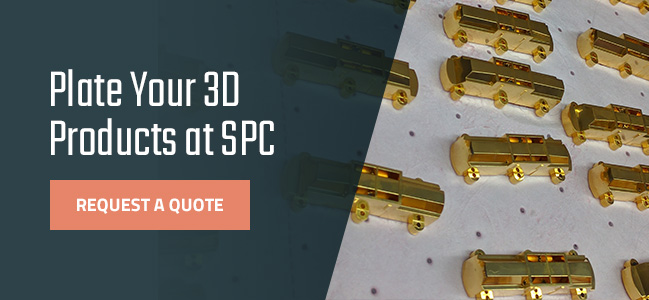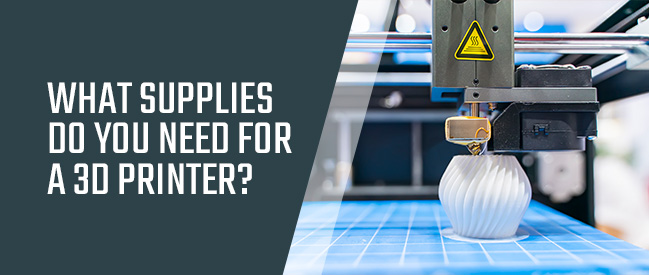
3D printing is a flexible, efficient and profitable approach to production, but it requires more than a printer and filament. Between storage, ventilation, handling materials and equipment configurations, your 3D printing budget must accommodate additional items, especially if you plan to utilize a 3D printer’s exceptional versatility.
Before you explore the world of 3D printing, you’ll need a thorough understanding of the process and all the 3D printing supplies you might need.
QUICK LINKS
Basic 3D Printer Supplies | Types of Printing Material | Cost of 3D Printing | Questions To Ask Before Buying a 3D Printer | Benefits of 3D Printing | Plate Your 3D Products at SPC
Basic 3D Printer Supplies
Of course, 3D printing starts with a printer. You can find many different types of 3D printers on the market,1 but some of the most popular styles for commercial users include:
- Stereolithography (SLA): SLA is one of the largest 3D printing technologies and is available to both hobbyists and professionals. These printers aim one or two lasers over a vat of resin,2 curing a small part of it. They build up the product in individual layers. They can use particularly strong lasers suitable for engineering-grade resins.
- Fused deposition modeling (FDM): FDM printers range from consumer-grade printers to industrial-grade. A filament wrapped around a spool gets fed through a nozzle,3 which heats and softens the filament. The nozzle then deposits the heated filament in layers that join together.
- Digital light printing (DLP): Many users opt for DLP printing to create larger parts or larger volumes of parts because this technology can flash an entire layer at one time rather than a small area.4
- Selective laser sintering (SLS): SLS printers use powdered materials.5 They heat the powder to just below its melting point, then deposit a thin layer of the material onto the build platform. A laser scans the surface in the selected pattern, sintering and solidifying the powder. The platform moves down a layer, and another layer of powder gets deposited.
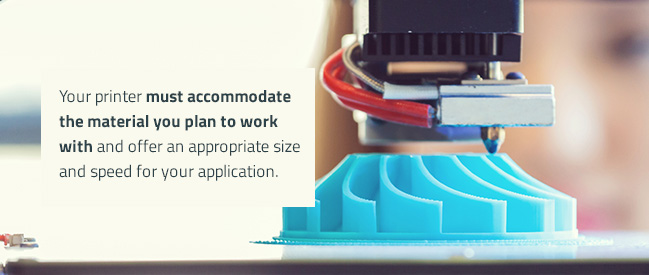
Specialized printers also exist to work with materials like concrete and biological matter. Your printer must accommodate the material you plan to work with and offer an appropriate size and speed for your application.
The next major component of 3D printing is the printing material. We’ll discuss these in more detail later, but common options include plastics, resin and metals.
While the necessary 3D printer accessories vary by application and printer, some items you may need include:
- Printing material storage containers: Keeping your printing material in good condition requires proper storage. You will need containers to store materials to prevent moisture and other environmental threats from damaging them. A plastic filament, for instance, may need an airtight container or desiccant pouches to absorb moisture and keep them from warping. Check with the manufacturer for more information on appropriate storage.
- Adhesives: Many projects benefit from adhesives used on the first layer to help the product stay in place on the printer bed. Materials like masking tape and glue can help keep this layer in place while providing easy removal after the product is finished. You may also need adhesives to connect different parts of your printed item during assembly.
- Build plates: Depending on the project, a build plate can help improve adhesion and surface finish for your print. Printers generally include a build plate, but you can purchase additional plates. Having different plates provides more versatility and performance in different situations while protecting your equipment for a longer life span.
- Ventilation equipment: 3D printing can release hazardous fumes that can lead to cellular damage, inflammation and oxidative stress,6 particularly when working with thermoplastics. You will need the appropriate equipment to safely work with the printer, such as respiratory masks, fans and fume extractors. Research your printing method and read the safety information related to your printer to learn more.
- Calipers: 3D parts typically call for precision and accuracy. A reliable set of calipers can provide the necessary measurements for quality assurance and verification.
- A toolset: If you need to access the inner workings of your 3D printer for maintenance and repairs, you will likely need a set of tools like screwdrivers and Allen keys.
- Finishing tools: After printing, 3D products often need finishing, such as sanding or carving. Sandpaper or sanders smooth out rough edges, while carving tools help you remove supports and create fine details. For significant production runs, you may need large-scale finishing equipment.
- Spatula: A tapered spatula wedges underneath the 3D part to separate it from the print bed without damaging the part. They are simple but essential for smaller operations.
- Nozzle sets: Depending on your printer and your application, you may need additional nozzles to accommodate varying print thicknesses. Smaller diameters can provide more precision, but larger ones can print faster. A set of different sizes offers versatility if you need to accommodate an array of print projects.
Types of Printing Material
3D printing materials can vary widely, with options that include plastic, powders, resins, metal and carbon fiber. These materials make 3D printing a promising option for many parts, from highly accurate aerospace and industrial machinery components to customized consumer goods.
1. Plastics
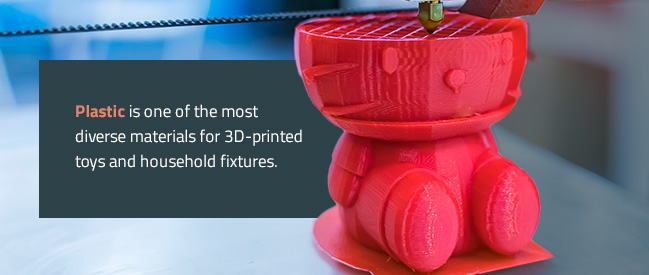
Out of all the raw materials for 3D printing in use today, plastic is the most common. Plastic is one of the most diverse materials for 3D-printed toys and household fixtures. Products made with this technique include desk utensils, vases and action figures. Available in transparent form as well as bright colors, plastic filaments are sold on spools and can have either a matte or shiny texture.
With its firmness, flexibility, smoothness and bright range of color options, the appeal of plastic is easy to understand. As a relatively affordable option, plastic is generally light on the pocketbooks of creators and consumers alike.
Plastic products are generally made with FDM printers, in which thermoplastic filaments are melted and molded into shape, layer by layer. The types of plastic used in this process are usually made from one of the following materials:
- Polylactic acid (PLA): One of the eco-friendliest options for 3D printers, polylactic acid is sourced from natural products like sugar cane and corn starch and is therefore biodegradable. Available in soft and hard forms, plastics made from polylactic acid will likely dominate the 3D printing industry in the coming years.7 Hard PLA is the stronger and, therefore more ideal material for a broader range of products.
- Acrylonitrile butadiene styrene (ABS): Valued for its strength and safety, ABS is a popular option for home-based 3D printers. Also referred to as “LEGO plastic,” the material consists of pasta-like filaments that give ABS its firmness and flexibility. ABS is available in various colors that make the material suitable for products like stickers and toys. It is popular among hobbyist printers but also used in commercially made consumer goods.
- Polyvinyl alcohol plastic (PVA): Used in low-end home printers, PVA is a suitable plastic for support materials of the dissolvable variety. Though not suitable for products that require high strength, PVA can be a low-cost option for temporary-use items.
- Polycarbonate (PC): Less frequently used than the aforementioned plastic types, polycarbonate only works in 3D printers that feature nozzle designs and that operate at high temperatures. Among other things, polycarbonate is used to make low-cost plastic fasteners and molding trays.
Plastic items made in 3D printers come in a variety of shapes and consistencies, from flat and round to grooved and meshed. A quick search of Google images will show a novel range of 3D-printed plastic products such as cog wheels and Incredible Hulk action figures. Home craftspeople can even buy polycarbonate spools at most supply stores.
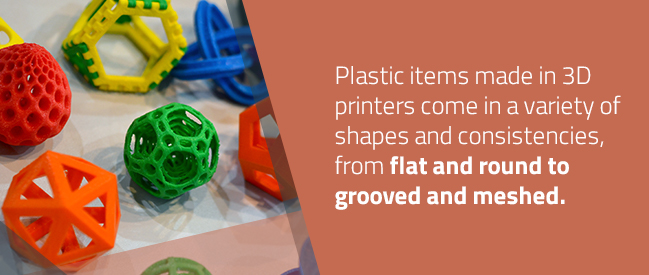
2. Powders
Today’s more state-of-the-art 3D printers use powdered materials to construct products. Inside the printer, the powder is melted and distributed in layers until the desired thickness, texture and patterns are made. The powders can come from various sources and materials, but the most common are:
- Polyamide (Nylon): With its strength and flexibility, polyamide allows for high levels of detail on a 3D-printed product. The material is especially suited for joining pieces and interlocking parts in a 3D-printed model. Polyamide is used to print everything from fasteners and handles to toy cars and figures.
- Alumide: Comprised of a mix of polyamide and gray aluminum, alumide powder makes for some of the strongest 3D-printed models. Recognized by its grainy and sandy appearance, the powder is reliable for industrial models and prototypes.
In powder form, materials like steel, copper and other types of metal are easier to transport and mold into desired shapes. As with the various types of plastic used in 3D printing, metal powder must be heated to the point where it can be distributed layer-by-layer to form a completed shape.
3. Resins
One of the more limiting and, therefore, less-used materials in 3D printing is resin. Compared to other 3D-applicable materials, resin offers limited flexibility and strength. Made of liquid polymer, resin reaches its end state with exposure to UV light. Resin is generally found in black, white and transparent varieties, but certain printed items have also been produced in orange, red, blue and green.
The material comes in the following three categories:
- High-detail resins: Generally used for small models that require intricate detail. For example, four-inch figurines with complex wardrobe and facial details are often printed with this grade of resin.
- Paintable resin: Sometimes used in smooth-surface 3D prints, resins in this class are noted for their aesthetic appeal. Figurines with rendered facial details are often made of paintable resin.
- Transparent resin: This is the strongest class of resin and therefore the most suitable for a range of 3D-printed products. This resin is often used for models that must be smoother to the touch and transparent in appearance.
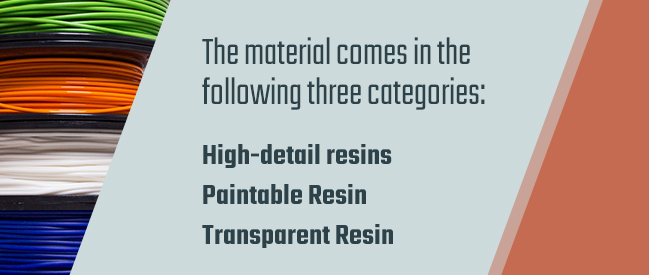
Transparent resins of clear and colored varieties are used to make figurines, chess pieces and small household accessories and fixtures.
4. Metals
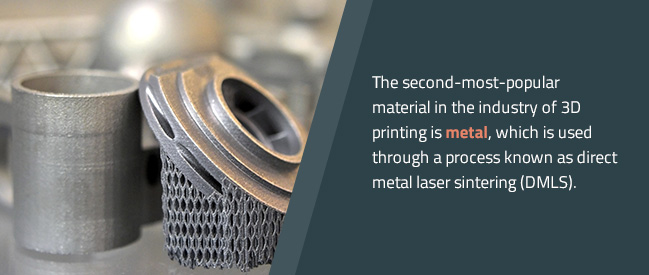
The second-most-popular material in the industry of 3D printing is metal, which is used through a process known as direct metal laser sintering (DMLS). This technique has already been embraced by manufacturers of air-travel equipment who have used metal 3D printing to speed up and simplify the construction of component parts.
Metal can produce a stronger and arguably more diverse array of everyday items. One of the main advantages of this process is that the printer handles the engraving work. As such, products can be finished by the box-load in just a few mechanically programmed steps that do not involve the hands-on labor that engraving work once required.
The technology for metal-based 3D printing is also opening doors for machine manufacturers to ultimately use DMLS to produce at speeds and volumes that would be impossible with current assembly equipment. Supporters of these developments believe 3D printing would allow machine-makers to produce metal parts with strength superior to conventional parts that consist of refined metals.
The range of metals that apply to the DMLS technique is just as diverse as the various 3D printer plastic types:
- Stainless steel: Ideal for printing out components that could ultimately come into contact with water.
- Bronze: Can be used to make vases and other fixtures.
- Nickel: Suitable for the printing of coins.
- Aluminum: Ideal for thin metal objects.
- Titanium: The preferred choice for strong, solid fixtures.
In the printing process, metal is utilized in dust form. The metal dust is fired to attain its hardness. This allows printers to bypass casting and directly use metal dust in forming metal parts. Once the printing finishes, these parts can then be electro-polished and released to the market.
Metal dust is most often used to print prototypes of metal instruments, but it has also been used to produce finished, marketable products and field-ready parts. Powderized metal has even been used to make medical devices.
When metal dust is used for 3D printing, the process allows for fewer parts in the finished product. For example, 3D printers have produced rocket injectors that consist of just two parts, whereas a similar device welded in the traditional manner will typically consist of more than 100 individual pieces.
5. Other Materials
You’ll also find other materials used in 3D printing, such as:
- Carbon fiber: Composites like carbon fiber are used in 3D printers as a top coat over plastic materials. The purpose is to make the plastic stronger. The combination of carbon fiber over plastic has been used in the 3D printing industry as a fast, convenient alternative to metal. In the future, 3D carbon fiber printing is expected to replace the much slower process of carbon-fiber layup. With the use of conductive carbomorph, manufacturers can reduce the number of steps required to assemble electromechanical devices.
- Graphite and graphene: Graphene has become a popular choice for 3D printing because of its strength and conductivity. The material is ideal for device parts that need to be flexible, such as touchscreens. Graphene is also used for solar panels and building parts. Proponents of the graphene option claim it is one of the most flexible of 3D-applicable materials. It is light, strong and very electrically conductive.8
- Nitinol: As a common material in medical implants, nitinol is valued in the 3D printing world for its super-elasticity. Made from a mixture of nickel and titanium, nitinol can bend to considerable degrees without breaking. Even if folded in half, the material can be restored to its original shape. As such, nitinol is one of the strongest materials with flexible qualities. For the production of medical products, nitinol allows printers to accomplish things that would otherwise be impossible.
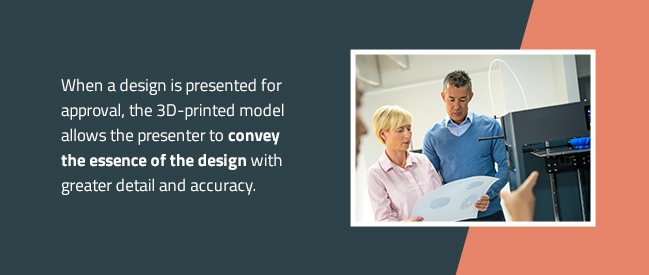
- Paper: Designs can be printed on paper with 3D technology to achieve a far more realistic prototype than a flat illustration. When a design is presented for approval, the 3D-printed model allows the presenter to convey the essence of the design with greater detail and accuracy. This makes the presentation far more compelling, as it gives a more vivid sense of the engineering realities should the design be taken to fruition.
Cost of 3D Printing
While 3D printing can offer cost savings, expenses go beyond the printer and printing material. Depending on your application, a 3D printer alone can cost between several hundred and tens of thousands of dollars. Cheaper models are typically inappropriate for commercial applications. Business-grade options might range from $1,000 to $5,000.9 The cost of industrial-sized 3D printers — usually SLS printers — goes up from there.
Printing materials similarly vary by application. Basic PLA 3D printer filament might cost less than $20 for a 1 kilogram (kg) spool.10 PETG filament is a similarly affordable option that offers food safety for around $20 per kg.11
Moving away from plastics, expect to spend more on resins and flexible materials like thermoplastics. Specialty materials, like those with metal, carbon fiber or polymer, are some of the most expensive.
Other costs to consider include 3D printing supplies, like those we listed earlier, and repair expenses. Over time, you may need to replace certain parts or pay for the skills of experienced technicians who can properly fix the equipment. You’ll also need to consider the costs of finishing tasks, such as heat treatment, metal machining and electroplating.
While the expenses of 3D printing vary widely, many companies still find significant cost savings from the efficient processes, short lead times and design flexibility.
Questions to Ask Before Buying a 3D Printer
If you’re considering buying a 3D printer, build a thorough picture of your requirements and options. Ask yourself these questions as you look for the right 3D printer:
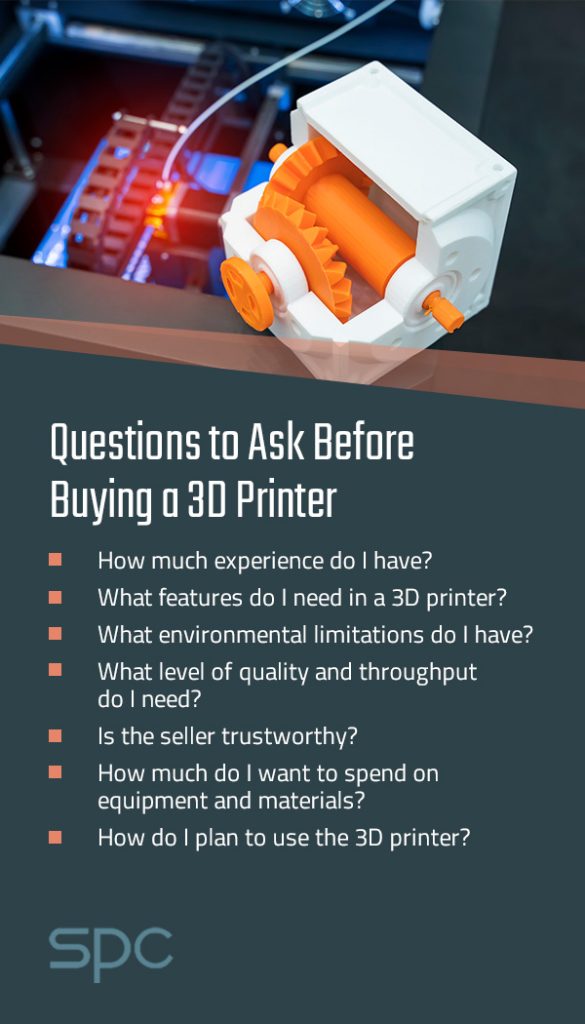
- How much experience do I have? Are you familiar with topics like CAD and minor equipment repairs? If not, you may need to hire someone to tackle these issues or spend time learning about them before making an investment in 3D printing. Some printers and materials are more beginner-friendly than others. Discuss your experience level with the seller to find the best fit.
- What features do I need in a 3D printer? Research your application and note features you may need, such as a large build plate, user-friendly software or direct drive extruders. Consider which features are must-haves and which would be convenient.
- What environmental limitations do I have? Determine where you will put your 3D printer. For large, industrial-grade printers, this task is especially important. Think about your space and whether you need a printer with a small footprint. Consider your ventilation, too, and whether you need to adjust your HVAC system to provide a safe environment.
- What level of quality and throughput do I need? The printer’s resolution determines print quality, while speed comes from the height it can achieve per hour. Carefully consider your intended use and how your printer will need to perform. High-volume production might call for a low-quality but fast print, while infrequently produced models would benefit from increased accuracy. You may need to trade one for the other or spend more on a well-rounded printer.
- Is the seller trustworthy? Make sure where you buy your printer from has a strong track record of customer satisfaction. Check reviews for both the seller and the manufacturer. Ask for sample prints that are representative of your intended application to see a real-world example of how a model performs.
- How much do I want to spend on equipment and materials? Some technologies cost more than others, so determine your budget and potential savings from 3D printing. Factor in all future costs, including supplies, repairs and education requirements. For example, if your team will need training on CAD, include those expenses in your budget.
- How do I plan to use the 3D printer? You may know what you need, or you might have many possibilities in mind. Keep your use cases in mind as you shop for a printer. If you plan to use your printer for various projects, you may need one that’s as versatile as possible. Alternatively, you could choose a printer designed for a specific task if you know exactly how you’ll use it.
Benefits of 3D Printing
Across industries, 3D printing comes with many advantages:
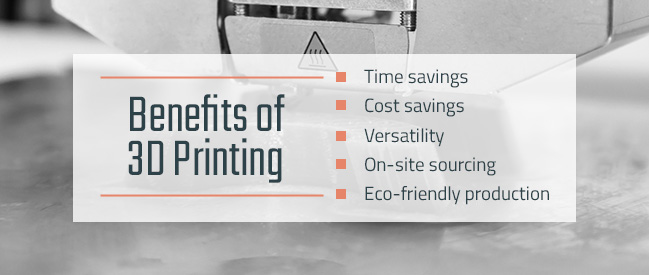
- Time savings: With on-demand printing capabilities, organizations can build parts immediately instead of waiting for a company to fabricate and ship them. They can eliminate downtime and long lead times. 3D printing can also speed up design processes and prototyping with quick, tangible products.
- Cost savings: Faster production capabilities can save on costs, as can the additive process of 3D printing. Since additive processes don’t require cutting material away, they reduce material costs and energy use for a more affordable approach to design and parts acquisition.
- Versatility: A 3D printer puts an unlimited number of parts at your disposal. It can replace rare or complicated components and expand the possibilities for designers and researchers. Even large-scale production lines benefit from the adaptability of 3D printing and the parts it produces.
- On-site sourcing: 3D printing can even reduce dependence on overseas manufacturing, such as metalworking and casting. It can support a streamlined supply chain and more in-house operations.
- Eco-friendly production: From reduced material waste to fewer shipping requirements, 3D printing helps many organizations meet their sustainability goals. It is a great way to meet environmental goals and improve the efficiency of business operations.
Plate Your 3D Products at SPC
At SPC, our extensive background with plating applications has allowed us to apply these capabilities to 3D-printed parts. In recent years, we have applied surface finishing to 3D parts manufactured by electronics and automotive companies as well as in numerous other industries. Regardless of your industry, we can customize a process that will suit your products.
Ultimately, companies that master this technology are bound to have an edge over their competition. Browse our 3D-print plating page16 to learn more about the options and contact us today for a free quote.17
Sources:
- https://hbr.org/2018/07/the-3-d-printing-playbook
- https://www.nature.com/articles/s43246-021-00145-y
- https://www.ala.org/tools/article/ala-techsource/types-3d-printing-fused-deposition-modeling
- https://www.sciencedirect.com/topics/engineering/digital-light-processing
- https://www.sciencedirect.com/topics/materials-science/selective-laser-sintering
- https://chemicalinsights.org/wp-content/uploads/2022/12/Chemical-Insights_3D-Toxicity-Report_final.pdf
- https://www.marketwatch.com/press-release/polylactic-acid-pla-market-research-2023-2030-2023-05-08
- https://pubs.rsc.org/en/content/articlelanding/2021/tc/d0tc04576d
- https://all3dp.com/2/how-much-does-a-3d-printer-cost/
- https://all3dp.com/1/best-3d-printer-filament/
- https://all3dp.com/1/best-3d-printer-filament/
- https://www.ge.com/additive/additive-manufacturing/industries/aviation-aerospace
- https://media.ford.com/content/fordmedia/feu/en/news/2023/02/08/ford-opens-new-3d-printing-centre-to-support-production-of-its-f.html
- https://www.sharrettsplating.com/blog/what-electroplating/
- https://www.sharrettsplating.com/blog/density-affects-plating-plastic-parts/
- https://www.sharrettsplating.com/industries/3D-printing-plating
- https://www.sharrettsplating.com/quotes/


